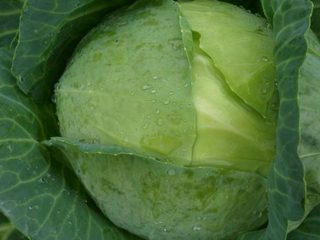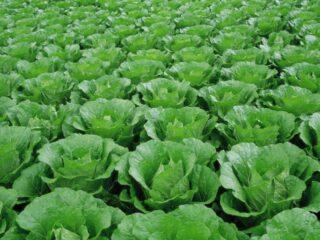Content
Cabbage is quite sensitive to the composition of the substrate. It quickly reacts to a deficiency or excess of certain macro- or microelements by changing its appearance. One of the common symptoms is cabbage leaves turning red. However, this can be caused not only by improper feeding, but also by negative external influences. You need to be able to correctly determine the cause - the measures taken directly depend on this.
Why did the cabbage turn red?
Cabbage most often turns red, “signaling” to the gardener that it is not satisfied with the quality of the substrate. “Imbalance” of macro- and microelements in most cases is caused by incorrect and/or untimely feeding. It may also be associated with adverse weather events.
Nutritional deficiencies
The leaves turn red due to a deficiency of macroelements, which can be called vital for plants. They require nitrogen in the early stages of the active growing season, without which it is impossible to grow green mass. Phosphorus is “responsible” for the process of formation and development of heads of cabbage, and, to a lesser extent, for their taste.
This manifests itself in different ways:
- With nitrogen deficiency, the process goes from bottom to top. It all starts with the veins of the lowest leaves. In cabbage they first turn yellow, then turn red, forming a “net”. With a slight “delay”, the color change affects the entire leaves. Somewhat less frequently, depending on the acid-base balance of the substrate, yellowness may give way to blue with a purple tint.
With a nitrogen deficiency, leaves not only turn yellow and red: they become very hard, and such heads of cabbage are of little use for food
- When a plant lacks phosphorus, the process goes from the edges of the surface leaf plates on the heads of cabbage to the center. Vague spots of irregular shape gradually merge, “capturing” it completely. If you do nothing, their shade becomes more intense. First, gardeners notice that the cabbage has turned dull pink, then crimson red and burgundy purple.
Phosphorus is vital for plants during the entire period of head formation.
If the cabbage leaves turn red, and this is not the only suspicious symptom, you need to carefully inspect the outlets for the presence of pests. When plants practically stop developing, lose their tone, the leaves not only turn red, but also wither and die, it is very likely that this is caused by a disease.
Adverse weather conditions
The most comfortable time for the crop is a fairly warm summer with moderate precipitation. Plant leaves often turn red when the weather differs significantly from what is optimal for the crop:
- With a sharp cold snap, growth practically stops. Leaves and stems turn pink or red, most often in spots.
- When cloudy, cold and rainy weather sets in for a long time, their hue varies from pink-red to blue-violet, depending on how uncomfortable the plants are.
- In extreme heat, in direct sunlight, cabbage can get burned. Depending on the “degree of severity” they partially turn yellow, red or brown.
When the weather is unfavorable, the leaf blades and stems turn red, even if you provide the plants with timely feeding and apply the necessary fertilizers. As the temperature decreases, the activity of soil microflora, which “decomposes” fertilizers into “components” in a form digestible by plants, decreases. The absorption capacity of the roots is also greatly affected; they are simply not able to “pull” everything they need from the soil in the required volume.
When there are heavy, prolonged rains, the situation gets even worse. Water “carries” the macro- and microelements necessary for the crop into the deep layers of the soil.
The root system of cabbage is well developed, but superficial, and it is not able to “reach” them. Therefore, indicating a deficiency, the leaf blades turn red. By the way, too frequent and/or abundant watering causes a similar reaction in the plant. The gardener is not able to influence the weather, but he is quite capable of “supporting” the plants with special preparations.
Why is red cabbage dangerous?
When cabbage turns red, this almost always leads to a slowdown in the development of rosettes or even a complete cessation of their growth. It is impossible to reap a good harvest in such conditions. The heads of cabbage turn out small and loose. Not only their keeping quality and transportability suffer, but also their taste.
Phosphorus deficiency makes cabbage more susceptible to rot. If it turns red for this reason and the gardener does nothing, it can almost certainly be said that he will soon lose the standing crop.
No less dangerous is the situation when the cabbage turns red due to a fungal disease or pest attack. Many of them can “spread” to other garden crops. With such attacks, not only the aesthetic appearance of the heads of cabbage suffers, they often become completely unsuitable for food.

When the leaves turn red, this symptom cannot be ignored: otherwise, the loss of most or all of the harvest is very likely
What to do if cabbage leaves turn red
When cabbage turns red, it is extremely important to correctly determine the cause of such negative changes. Otherwise, it is impossible to choose the right “treatment”.
Nitrogen deficiency, if it has appeared recently, is quite easy to cope with. The condition of cabbage is normalized within 7-10 days after feeding with mineral “mono-fertilizers”:
- urea;
- ammonium sulfate;
- ammonium nitrate.
Water-soluble granules can simply be distributed over the bed, incorporated into the soil during loosening and watered. Or cabbage that turns red is watered with a solution (10-15 g of fertilizer per 10 l).

Mineral nitrogen fertilizers are very easy to use, the effect of such fertilizing appears quite quickly
Phosphorus and potassium contain the vast majority of complex fertilizers - universal garden fertilizers or those designed specifically for cabbage. Also, if it turns red, you can feed it with simple or double superphosphate.
Among folk remedies, the most valuable source of phosphorus is wood ash. When the cabbage turns red, you can simply scatter it over the garden bed and loosen the soil, or water it with a pre-prepared infusion.

Superphosphate is often “enriched” with microelements; if the cabbage turns red, this option is preferable
If plants react to weather conditions, the gardener can only “support” them. For cabbage that turns red due to the cold, foliar feeding with a solution of any biostimulant will be very useful.

Biostimulants not only have a positive effect on the overall endurance of plants: they improve the quality of emerging heads of cabbage
Is it possible to eat cabbage if it is red?
If cabbage turns red due to a deficiency of macro- and microelements or due to unfavorable weather, in principle, it is edible both fresh and in any dishes or homemade preparations. However, the juiciness of the leaves and their taste leave much to be desired, therefore, if possible, they are used as livestock feed.
When the reason that cabbage turns red is a fungal disease or a pest attack, the question of its edibility is decided in each case “individually.” First of all, you need to take into account the degree of neglect of the lesion or the severity of the problem. Diseases for which you definitely can’t eat cabbage:
- clubroot;
- fusarium;
- late blight;
- all types of bacteriosis (mucosal, vascular, point);
- gray rot;
- late blight

If red leaves are not a characteristic feature of a particular type of cabbage, it is better to refrain from eating it
Preventive measures
It is easier to prevent any problem than to deal with negative consequences later. In order not to have to think about why cabbage leaves turn red, it is recommended to regularly devote a little time to preventive measures:
- Proper garden bed preparation in the fall. To maintain soil fertility, humus or rotted compost must be added at the end of each season. They are subsequently “processed” by beneficial soil microflora.
- Choosing a zoned variety or hybrid. Otherwise, cabbage leaves often turn red due to the fact that local climatic conditions are categorically unsuitable for it.
- Pre-planting seed treatment. For this purpose, both antifungal drugs (fungicides) and biostimulants are used. Both remedies reduce the likelihood that cabbage leaves will turn red during the season. And the biostimulator also has a positive effect on the volume and quality of the harvest.
- Planting only mature, fully formed seedlings into the garden bed. “Underdeveloped” seedlings are more sensitive to any negative external influences, which cause cabbage leaves to turn red.A very useful preventative measure is pre-hardening of seedlings.
- Choosing a planting date taking into account the weather. Plants should not be moved outdoors until the weather is consistently warm and the likelihood of return frosts has been minimized. Cabbage often turns red precisely because of the cold weather.
- Providing protection to plants if temperatures are predicted to drop. Arches are installed over the cabbage bed, and any covering material that allows air to pass through is pulled over them. Another method of protection is to treat the plantings with Epin diluted in cold water.
- Timely feeding during the season. Cabbage seedlings, as a rule, are not fertilized. After transplanting to the garden bed, 2-4 feedings are carried out, depending on the ripening period of the heads of cabbage. The first is necessarily nitrogen; then it is advisable to use complex fertilizers. It is because of the deficiency of macro- and microelements that cabbage leaves turn red most often.
- Prevention of disease infection and pest attacks. It is carried out taking into account the presence of immunity in a variety or hybrid or, conversely, its “propensity” to a certain problem. Also, treatments are repeated if weather conditions favor the activation of pathogenic microflora and insects for a long time, which is why the cabbage leaves turn red.
Conclusion
The fact that cabbage leaves turn red is often the fault of the gardener himself, who is overly zealous with fertilizing or carries it out haphazardly. But this is not the only possible reason - sometimes plants react this way to the vagaries of the weather.It is very important to reliably determine what the problem is - otherwise it will be impossible to restore the healthy appearance of cabbage.










